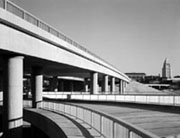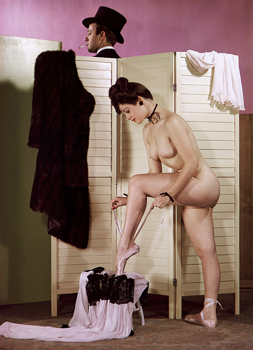Richard Miller: Over the Long Run
Vintage Carbro Prints, The Hollywood Freeway and L.A. in B/W
February 27 - April 17, 2010
Reception: February 27, 2010 4-6 PM
In the spring of 2009, Richard C. Miller’s photographic career was given long overdue recognition in the form of an exhibition at the Getty Museum. As a practitioner of the exceptionally stable color process known as carbro printing, Miller’s work was positioned adjacent to an exhibit of one of the masters of that technique-- Paul Outerbridge. Carbro printing, a difficult and time-consuming process requiring the layering of cyan, magenta and yellow pigment separations, was exploited by Outerbridge and Miller for both commercial and fine art applications. In fact, a career breakthrough occurred for Miller in 1941 when he submitted a carbro print to the Saturday Evening Post. The image depicted his daughter Linda praying at the Thanksgiving table while peaking at the turkey. It became one of the first color photographs to displace Norman Rockwell on the magazine’s cover. Miller’s color work from the 1940s included several other similarly staged scenes such as Linda being surprised by a chick popping out of an Easter egg that she’s painting, as well as nudes, still-lifes, a series of women in wildly colorful, feathery, and fruit-laden hats, and dozens of images of a young model named Norma Jeane Dougherty (who later became Marilyn Monroe.)
Miller’s black and white work was equally significant, and in some ways, ahead of its time. From 1948-1953 he photographed the building of the Hollywood Freeway, not on assignment or for other commercial purposes, but because he was in awe of its monumentality. As he said, “…this is how the people must have felt when they first saw cathedrals in Europe…the first day the four-level opened, I drove around and around just to experience it.” The early images of construction, however, are more about displacement, bulldozed neighborhoods, and dirt fields scattered with construction debris and random dying foliage. Writing about this body of work, the author Judith Freeman noted that, “no one was making pictures like these back then, and no one would have appreciated them at the time. In Miller’s photographs we find the precursor to the work of the New Topographic photographers Lewis Baltz, Robert Adams and Joe Deal.”
In addition to his carbro work and Hollywood Freeway photos, the exhibition at Craig Krull Gallery will include a trove of vintage pictures from the 1930s-50s of Los Angeles at night, the city’s grand boulevards, self-portraits boxing, the Good Humor Man, beaches, parking lots, gas stations, Steinbeckian views of the Central Valley, James Dean on and off the set of Giant, a selection of striking portraits including some of his best friend Brett Weston, costume parties at Edward Weston’s Wildcat Hill, pictures made while driving, the dunes at Oceano, and aviation photos made while working at North American.


